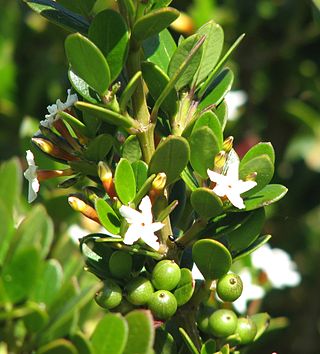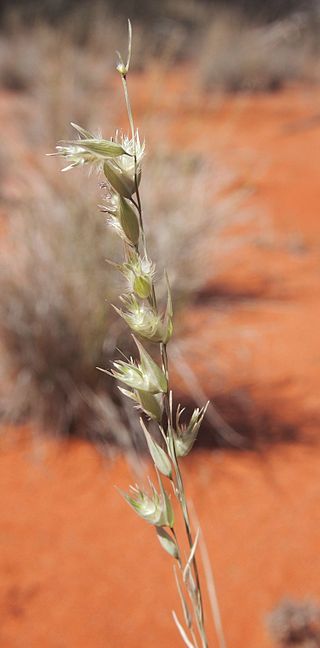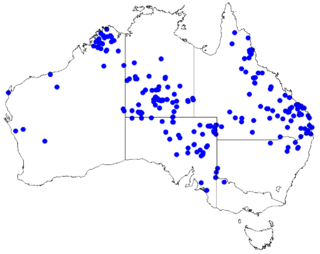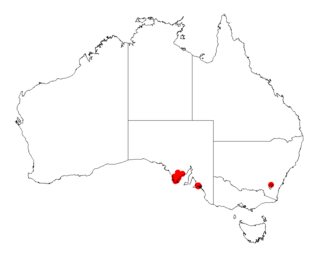
Acacia coriacea, commonly known as river jam, wirewood, desert oak, wiry wattle or dogwood, is a tree in the family Mimosoideae of family Fabaceae. Indigenous Australians know the plant as Gunandru.

Podolepis is a genus of flowering plants in the tribe Gnaphalieae within the family Asteraceae. It is endemic to Australia and can be found in every state.

Callitris endlicheri, commonly known as the black cypress pine, is a species of conifer in the family Cupressaceae. It is found only in Australia, occurring in Queensland, New South Wales, the Australian Capital Territory, and Victoria.

Callitris oblonga, also known as the South Esk pine, pygmy cypress pine, pigmy cypress pine, river pine, or Tasmanian cypress pine, is a species of conifer in the family Cupressaceae. It is endemic to Australia, where it is native to New South Wales and Tasmania, with one subspecies introduced in Victoria. It is considered vulnerable and faces a number of threats including land clearing, habitat degradation, and damage from or competition with invasive species.

Ageratina riparia, commonly known as mistflower, is a species of flowering plant in the family Asteraceae, native to Mexico. The species is widely adventive and has spread to Cuba, Jamaica, and other parts of the Caribbean. It has also been introduced as an ornamental plant and naturalized in a variety of regions, including parts of Hawaii, South Africa, Southeast Asia, Macaronesia, Oceania, Peru, and the Indian subcontinent. In tropical climates, A. riparia is highly invasive and a variety of control methods have been developed to reduce its spread.

Leucopogon parviflorus, commonly known as coast beard-heath or native currant, is a shrub or small tree in the family Ericaceae. It is native to all Australian states and territories excluding the Northern Territory and the ACT and also grows in New Zealand. The species can grow to between 1 and 5 metres in height and has leaves that are 11 to 29 mm long and 2.4 to 7.5 mm in width, often with curved tips. The white flowers are around 15 mm long and are produced in spikes of 7 to 13. These occur throughout the year.

Alyxia buxifolia, otherwise known as the sea box or dysentery bush, is a species of evergreen shrub in the family Apocynaceae.

Erodium cygnorum is a species of herb native to Australia.

Monachather, common name mulga oats, is a genus of Australian plants in the grass family.

Asteridea is a genus of flowering plants in the family Asteraceae. Evidence suggests that the genus, Asteridea, is monophyletic.

Seringia integrifolia is a shrub of the family Malvaceae native to inland Australia in New South Wales, South Australia, Western Australia, Queensland, and the Northern Territory.

Wahlenbergia queenslandica is a small herbaceous plant in the family Campanulaceae native to Western Australia, to New South Wales, Queensland, the Northern Territory, and South Australia.
Hellmut R. Toelken is a South Australian botanist. He retired in December 2008 from the position of senior biologist at the State Herbarium of South Australia, but remains an honorary research associate. Earlier he was with the Botanical Research Institute, Department of Agricultural Technical Services, Pretoria, S Africa.

Acacia pinguifolia, commonly known as the Fat-leaved wattle or Fat-leaf wattle, is endemic to South Australia, and is listed as an endangered species. It is in the Plurinerves section of the Acacias.

Commersonia craurophylla is a species of flowering plant in the family Malvaceae and endemic to Australia. It is a hairy-stemmed shrub. The leaves have entire margins, and are covered in both simple and stellate hairs.

Westringia rigida is a shrub in the Lamiaceae family that is endemic to Australia. and

Senecio quadridentatus is native to Australia and New Zealand. In New Zealand it is known by its Māori name pahokoraka or pekapeka. Senecio quadridentatus is an annual or perennial herbaceous flowering plant in the family Asteraceae. It is also known as Erechtites quadridentata Labill by the synonyms.

Wessel Marais B.Sc., M.Sc. (1929-2013) was a South African botanist and plant collector.

Peplidium foecundum is a plant in the Phrymaceae family, native to South Australia, Queensland, the Northern Territory and New South Wales.

Macgregoria racemigera is a small plant in the family Celastraceae) found in inland Australia from New South Wales through Queensland, the Northern Territory to Western Australia, and South Australia.



















